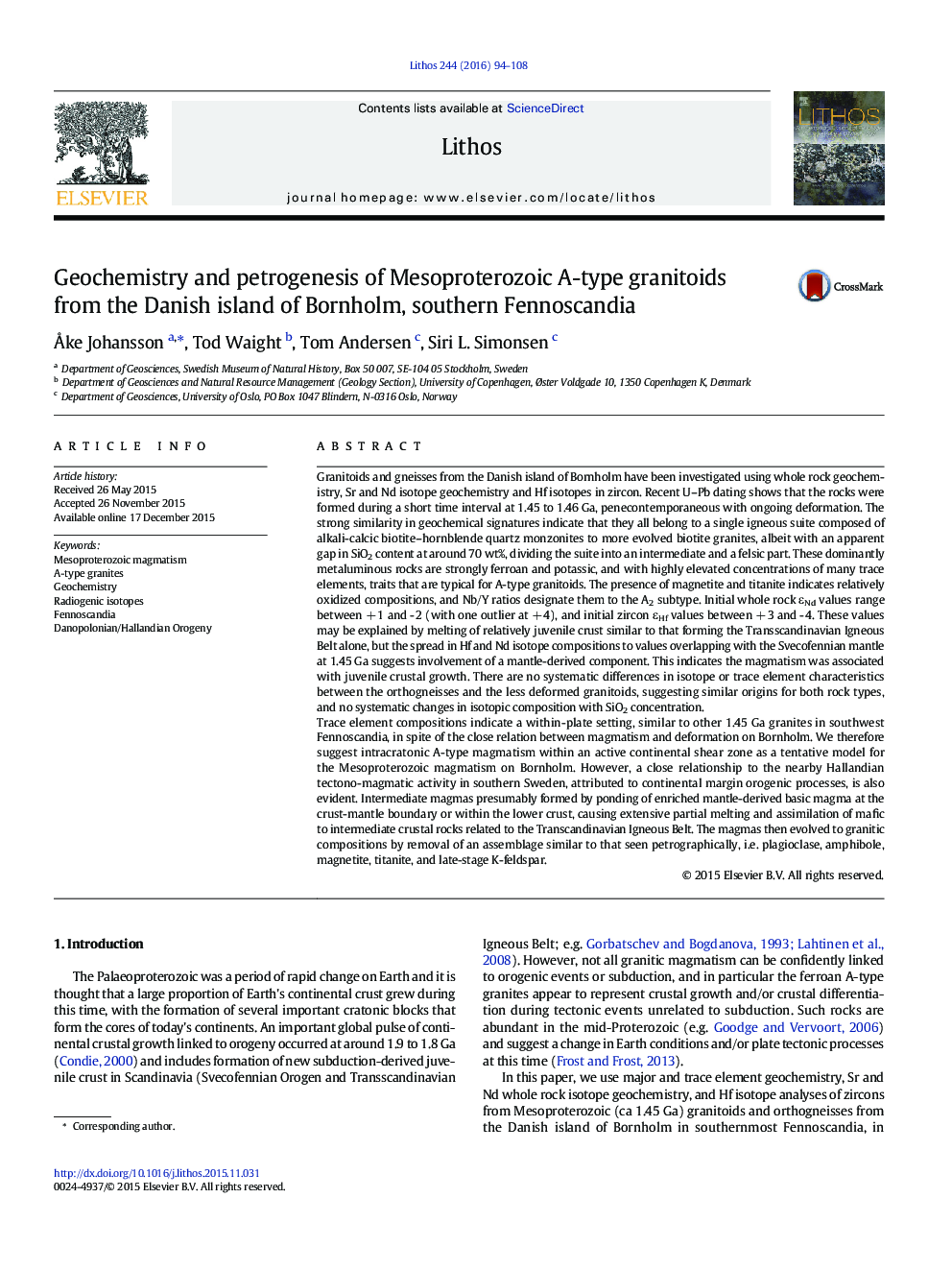| کد مقاله | کد نشریه | سال انتشار | مقاله انگلیسی | نسخه تمام متن |
|---|---|---|---|---|
| 4715649 | 1638652 | 2016 | 15 صفحه PDF | دانلود رایگان |

• The Bornholm granitoids and orthogneisses form one single magmatic suite.
• They are located in southernmost Fennoscandia and are ca 1.45 Ga old.
• They are metaluminous, alkali-calcic, potassic and ferroan, oxidized A-type granitoids.
• They have within-plate signature, and may have formed along an intra-cratonic shear zone.
• Nd and Hf isotopes suggest a mixed mantle-crustal origin for the magma.
Granitoids and gneisses from the Danish island of Bornholm have been investigated using whole rock geochemistry, Sr and Nd isotope geochemistry and Hf isotopes in zircon. Recent U–Pb dating shows that the rocks were formed during a short time interval at 1.45 to 1.46 Ga, penecontemporaneous with ongoing deformation. The strong similarity in geochemical signatures indicate that they all belong to a single igneous suite composed of alkali-calcic biotite–hornblende quartz monzonites to more evolved biotite granites, albeit with an apparent gap in SiO2 content at around 70 wt%, dividing the suite into an intermediate and a felsic part. These dominantly metaluminous rocks are strongly ferroan and potassic, and with highly elevated concentrations of many trace elements, traits that are typical for A-type granitoids. The presence of magnetite and titanite indicates relatively oxidized compositions, and Nb/Y ratios designate them to the A2 subtype. Initial whole rock εNd values range between + 1 and - 2 (with one outlier at + 4), and initial zircon εHf values between + 3 and - 4. These values may be explained by melting of relatively juvenile crust similar to that forming the Transscandinavian Igneous Belt alone, but the spread in Hf and Nd isotope compositions to values overlapping with the Svecofennian mantle at 1.45 Ga suggests involvement of a mantle-derived component. This indicates the magmatism was associated with juvenile crustal growth. There are no systematic differences in isotope or trace element characteristics between the orthogneisses and the less deformed granitoids, suggesting similar origins for both rock types, and no systematic changes in isotopic composition with SiO2 concentration.Trace element compositions indicate a within-plate setting, similar to other 1.45 Ga granites in southwest Fennoscandia, in spite of the close relation between magmatism and deformation on Bornholm. We therefore suggest intracratonic A-type magmatism within an active continental shear zone as a tentative model for the Mesoproterozoic magmatism on Bornholm. However, a close relationship to the nearby Hallandian tectono-magmatic activity in southern Sweden, attributed to continental margin orogenic processes, is also evident. Intermediate magmas presumably formed by ponding of enriched mantle-derived basic magma at the crust-mantle boundary or within the lower crust, causing extensive partial melting and assimilation of mafic to intermediate crustal rocks related to the Transcandinavian Igneous Belt. The magmas then evolved to granitic compositions by removal of an assemblage similar to that seen petrographically, i.e. plagioclase, amphibole, magnetite, titanite, and late-stage K-feldspar.
Journal: Lithos - Volume 244, 1 February 2016, Pages 94–108